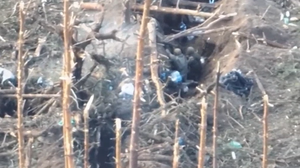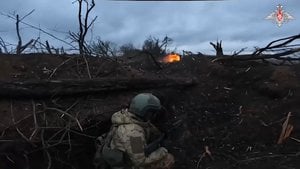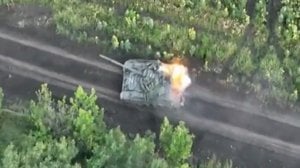
Strategic Air Power Then and Now - Archival Footage of WW II Bombing
Published 1 years ago
Archival footage of allied bombing of targets by B-25 Mitchell medium bombers, courtesy of British Pathé. The bombing of strategic targets by Allied forces in World War II played a significant role in the defeat of Nazi Germany and provides interesting lens through which to examine the air campaigns being waged over Ukraine and Russia. Let us see what the footage can tell us.
Strategic bombing campaigns waged during the Second World War focused on the targeting of urban areas and the destruction of ports, railyards, factories, refineries, and housing occupied by factory workers. A tertiary goal was the demoralization of the enemy civilian population in the hopes of eroding popular support for the war effort. Strategic bombing during the war began in 1939 with the German bombardment of Polish cities, but the approach was also adopted by the allies and became a critical factor in the eventual destruction of the Nazi war machine. Allied medium and heavy bombers struck industrial targets, degrading Germany’s ability to produce critical components for military equipment; they struck port and rail facilities, disrupting strategic lift and operational mobility; and attacks against oil fields and refining facilities starved the Third Reich of fuel, immobilizing entire divisions.
The campaign was neither easy nor without controversy. Prior to the Allied landings in Normandy in June 1944, the campaign relied on long-range heavy bombers, such as the B-17 flying fortress, operating from airfields in Britain. The fighter escorts available lacked the range to protect bombers all the way to their targets, leaving the bomber crew vulnerable to both German anti-aircraft fire and Luftwaffe fighters and resulting in terrible losses of men and aircraft. The eventual seizure of airfields in Frace and the arrival of Allied fighters with greater range decreased the distance bomber crews were required to fly to reach their targets while increasing the protection they were afforded during their missions. In addition to being costly, high-altitude bombing was not very accurate, and large raids dropping thousands of tons of bombs were required to destroy industrial targets, and the collateral damage inflicted on civilian targets was extensive. Ultimately, the campaign played its role in disrupting the Nazi war economy and contributed to the eventual defeat of the Third Reich.
Russia’s war in Ukraine has resulted in the emergence of two distinct air strategies as each belligerent pits the capabilities that they can muster against the enemy’s vulnerabilities. Russia began the war as the dominant air power, and many observers assumed that thar their advantages in fighter aircraft, tactical and strategic bombers, ballistic missiles, cruise missiles, and air defense systems would yield a swift and decisive victory. This did not happen. Russia’s initial use of offensive airpower was disjointed and ineffective, fighters and air defense systems failed to protect Russian ground forces, and Russian units seemed incapable of coordinating airstrikes with maneuver on the ground. Over the last year, Russian air strategy and tactics have evolved, although this evolution seems largely reactive. At the tactical level, fixed and rotary-wing attack aircraft continue to provide air support to ground forces, though actions are not well coordinated, and the cost is high, with at least two-fifths of Russia’s Ka-52 attack helicopters having been destroyed, and many ground-attack fighters having been lost to antiaircraft fire and operational mishaps. At the operational level, Russia has modified dumb bombs into guided glide bombs, which they are able to launch beyond the reach of Ukrainian air defense systems.
Russia’s strategic air campaign predominantly relies on the use of missiles and drones, and the results are inconclusive. Over the winter, Russia attempted to target Ukrainian energy facilities in efforts to freeze the population into submission, an effort the failed. Currently, they periodically target civilian centers of questionable military value, and although Ukrainian air defenses intercept many most incoming missiles and drones, some inevitably leak through and inflict civilian casualties. Once can only surmise that the purpose of these strikes is to break the will of the Ukrainian people, an effort that appears entirely unsuccessful. Another aspect of the strategic air campaign is yielding greater results is the targeting of Ukrainian port facilities in Odessa oblast. By withdrawing from the Black Sea Grain Initiative and striking Ukrainian grain terminals, Russia has disrupted a major source or revenue for Ukraine while increasing the value of its own grain exports. By offering grain to developing countries, Russia can increase its influence on the developing world, forcing the world to rely on Russian grain, albeit at the point of a gun. Ukraine is forced to risk the use of these ports, or to attempt to export their grain through Europe via rail. Not only is this method more costly and less efficient, but it places political pressure on European allies supporting Ukraine. Exporting Ukrainian grain through Poland reduces the value of Polish wheat, placing the Poles in ana awkward position, and for this reason overland export routes for Ukrainian grain have been slow to develop. While this aspect of the Russian strategic air campaign does possess some political and economic benefits for Russia, no aspect of their campaign attempts to disrupt Ukraine’s warmaking capability in any meaningful way.
Ukraine’s use of airpower is more clearly aligned with defined military objectives. Though Ukrainian fixed and rotary wing platforms continue to fly, their capabilities and numbers limit effectiveness, forcing Ukraine to rely on drones and cruise missiles. Both aircraft and drones have proved invaluable in a tactical role, striking Russian targets directly or spotting for ground-based artillery systems, enabling accurate engagement of Russian materiel, units, and artillery systems. At an operational level, Ukrainian airpower in the form of drones have delivered the targeting data required for systems such as HIMARS to provide effective shaping fires, destroying command and control and logistics nodes. However, beyond the immediate concerns of the battlefield, Ukraine’s strategic air campaign has only recently begun to take shape. Its two goals are creating conditions to permit the liberation of Crimea; the degradation of Russian warmaking capacity by striking military, industrial, and governmental targets in Russia and the disruption of Russian society and its will to sustain the war.
Ukraine’s shaping operations in and around Ukraine focus on severing its links with Russia by destroying the Kerch Strait bridge and by limiting the operational effectiveness of the Russian Black Sea Fleet. Joint air and naval efforts to these ends have had some modest success, but Russian defenses have proved resilient, and in particular, Ukrainian drones and Stormshadow cruise missiles have breached air defenses in Crimea only with come difficulty. It is hoped that the arrival of F-16s will allow Ukraine to suppress enemy air defenses to a degree that will allow existing munitions to reach their targets. Ukraine’s efforts to degrade Russian warmaking capacity are only just beginning to take shape and have largely utilized various types of drones to attack targets within Russia. These include the use of carboard drones to attack Russian strategic bombers, and while the loss of a few places represents a only a fraction of the Russian fleet, the attacks do force Russia to react in order to protects its assets. The recent Ukrainian drone attack against an electronics plant in Bryansk is one of the first clear strikes against Russian defense industry. Sanctions have already left Russian manufacturers starving for high-end western electronics and struggling to produce the modern weapons required to win on today’s battlefield. The attack in Bryansk is a clear effort to exploit this weakness and to undermine Russia’s ability to sustain the war in the long term.
The allied strategic bombing campaign during World War II was controversial and costly, but it contributed both directly and indirectly to allied strategic objectives. Of the two sides slugging it out in Ukraine, only the Ukrainians have developed a coherent air strategy, despite their limited means. Russian use of missiles and drones against civilian targets does not advance any identifiable strategic objective and appears more like the flailing of a petulant child. Though attacks against ports appear more promising, they are not decisive, and they carry the risk of accidentally striking NATO allies and eliciting a response. Ukrainian actions in the air are clearly connected to tactical, operational, and strategic goals, but at the strategic level they lack the resources to be decisive. It will be interesting to see if increased domestic production of drones and cruise missiles, and the arrival of advanced fighter aircraft, will grant Ukraine the means to shape events from the air.
About the Author

Cam
Cam served as an infantry officer in the Marine Corps, deploying to the Horn of Africa and participating in combat operations in Iraq. He currently works in the maritime industry and in the defense sector as an instructor of combined arms planning and operations. An avid sailor, Cam founded and directs a nonprofit that supports veterans and first responders through sailing.













